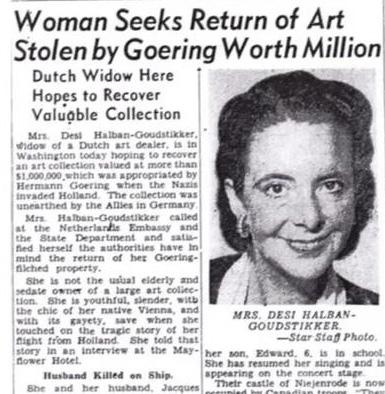The Cultural Plunder by the Nazis O
ver the centuries, middle- and upper-middle class Jews assimilated into the mores and customs of the countries in which they lived. They collected art which went far beyond the strict confines of Jewish-themed works. Wealthy Jews had a predilection for Old Master paintings and Christian objects while many Jewish art dealers and collectors favored 19th and 20th century works and promoted modernist creative expression. These dealers and collectors also acquired antiquities from MARC around the world, MASUROVSKY decorative objects from remote regions, period furniture, textiles, indigenous artifacts, rare books, incunabula, and carefully-designed bejew-
eled objects. Middle- and upper middleincome Jews across Europe amassed valuable collections which meant that their cultural assets became a privileged target of Nazi-ordered seizures. In a way, Nazi art looting, in the context of anti-Jewish persecution, embodied a rejection of the success, taste and worldliness of their victims, even if the Nazis shared with their victims similar esthetic preferences. These similarities brought together professionally and socially Jewish dealers and collectors with their non-Jewish clients and associates, many of whom threw their lot with the Nazis and partook in the events of the Holocaust. When the Nationalist Socialists came to power in Germany in January 1933, they launched a radical overhaul of Germany’s cultural landscape designed to uproot artistic movements and modes of expression that they felt contradicted and violated
the tenets of National Socialism and stood in the way of establishing a new Germanic and Aryan culture. By taking aim at all representatives of a certain idea of modernism in the art world and its proponents in academic, literary and museum circles, the Nazis engaged in a wholesale purge of German culture and art. Cultural plunder encompasses the varied ways in which the Nazis dispossessed their Jewish victims by forcibly expropriating their property, seizing their businesses, transferring their assets into non-Jewish hands through a process known as “Aryanization” and depriving them of their livelihood. The Nazis subjected Jews to a daily regimen of persecution, exemplified by beatings, physical threats, psychological intimidation, arbitrary arrests and internment, which, over time, reduced their ability to function in civil society, restricting their movements in public, making life
The Oriental Antiquities room of the Louvre Museum serves as a storage space for looted works of art. France, 1943-1944.
4
HOLOCAUST REMEMBERED |
APRIL 27, 2022
|
Supplement created and paid for by the SOUTH CAROLINA COUNCIL ON THE HOLOCAUST
untenable for the vast majority of Jews left unprotected at the mercy of the population. A perpetual state of duress cast a pall on every decision that a Jew made in Nazi Germany, driven by a desperate need to survive and to escape to a foreign haven where they could resume a semblance of a “normal life.” Nazi policies and initiatives deprived most Jews of a regular income. In order to survive, Jews were forced to sell off their belongings, including works and objects of art, at whatever price they could obtain either through private sales or auctions. Oftentimes, the prices fell far short of the actual market value of their property. These forced sales resulted from daily acts of duress. The funds accrued at these forced sales were transferred to the Nazi authorities as payment for exit fees and exorbitant taxes levied on Jewish assets. Art dealers abetted the Nazi-sponsored expropriations of Jewish cultural assets. In many instances, they approached their Jewish clients and made it clear that they had no choice but to sell them their property at whatever price they offered as in the case of Lilly Cassirer Neubauer who was forced to sell a painting by Camille Pissarro in 1939 to Munich art dealer Jakob Scheidwimmer. The painting is now at the Museo Thyssen-Bornemisza in Madrid (Spain) and the subject of a major international legal claim for its restitution. Jewish art dealers like Max Stern of Düsseldorf received official notifications from Nazi authorities to liquidate their stock and shutter their businesses. Auction houses like Lempertz in Köln were involved in the reselling of liquidated and expropriated Jewish-owned works and objects of art. Some of the looted art sold at these auctions ended up decades later in private and public collections in Europe and America. Victims’ families and independent researchers have been uncovering them over the past decades, resulting in a number of restitution claims. The plunder of Jewish victims’ property unfolded alongside the extermination campaign waged by the Nazis against the Jews of Europe. It extended from Norway to Odessa and the Baltic States — engulfing most of Europe except for the so-called “neutral countries” (Sweden, Switzerland, Spain, Portugal) which profited from doing




















